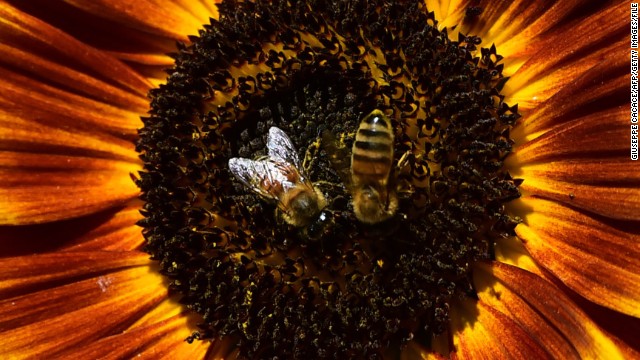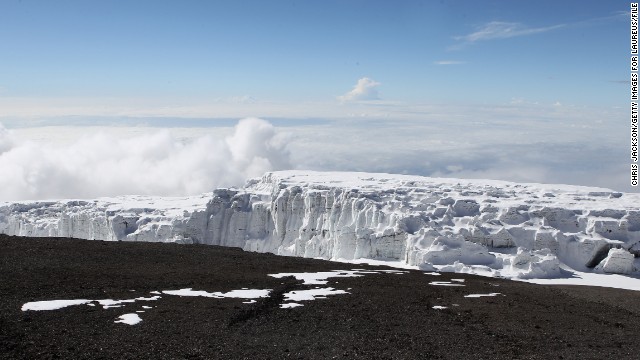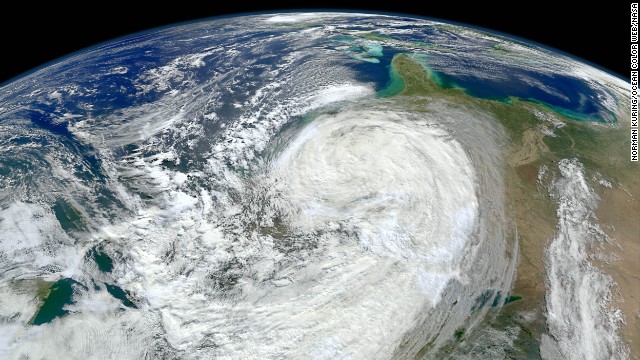 The consequences of climate change go far beyond warming temperatures, which scientists say are melting the polar ice caps and raising sea levels. Meet the team that is measuring climate change in the Arctic on CNN's series. And click through the gallery for a look at 10 other key effects of climate change, some of which may surprise you.
The consequences of climate change go far beyond warming temperatures, which scientists say are melting the polar ice caps and raising sea levels. Meet the team that is measuring climate change in the Arctic on CNN's series. And click through the gallery for a look at 10 other key effects of climate change, some of which may surprise you.  Drought: In the coming decades climate change will unleash megadroughts lasting 10 years or more, according to a new report by scholars at Cornell University, the University of Arizona and the U.S. Geological Survey. We're seeing hints of this already in many arid parts of the world and even in California, which has been rationing water amid record drought. In this 2012 photo, a man places his hand on parched soil in the Greater Upper Nile region of northeastern South Sudan.
Drought: In the coming decades climate change will unleash megadroughts lasting 10 years or more, according to a new report by scholars at Cornell University, the University of Arizona and the U.S. Geological Survey. We're seeing hints of this already in many arid parts of the world and even in California, which has been rationing water amid record drought. In this 2012 photo, a man places his hand on parched soil in the Greater Upper Nile region of northeastern South Sudan.  Wildfires: There's not a direct link between climate change and wildfires, exactly. But many scientists believe the increase in wildfires in the Western United States is partly the result of tinder-dry forests parched by warming temperatures. This photo shows a wildfire as it approaches the shore of Bass Lake, California, in mid-September.
Wildfires: There's not a direct link between climate change and wildfires, exactly. But many scientists believe the increase in wildfires in the Western United States is partly the result of tinder-dry forests parched by warming temperatures. This photo shows a wildfire as it approaches the shore of Bass Lake, California, in mid-September.  Coral reefs: Scientists say the oceans' temperatures have risen by more than 1 degree Fahrenheit over the last century. It doesn't sound like much, but it's been enough to affect the fragile ecosystems of coral reefs, which have been bleaching and dying off in recent decades. This photo shows dead coral off the coast of St. Martin's Island in Bangladesh.
Coral reefs: Scientists say the oceans' temperatures have risen by more than 1 degree Fahrenheit over the last century. It doesn't sound like much, but it's been enough to affect the fragile ecosystems of coral reefs, which have been bleaching and dying off in recent decades. This photo shows dead coral off the coast of St. Martin's Island in Bangladesh.  Food prices: A U.N. panel found in March that climate change -- mostly drought -- is already affecting the global agricultural supply and will likely drive up food prices. Here, in 2010, workers on combines harvest soybeans in northern Brazil. Global food experts have warned that climate change could double grain prices by 2050.
Food prices: A U.N. panel found in March that climate change -- mostly drought -- is already affecting the global agricultural supply and will likely drive up food prices. Here, in 2010, workers on combines harvest soybeans in northern Brazil. Global food experts have warned that climate change could double grain prices by 2050.  Pollen allergies: Are you sneezing more often these days? Climate change may be to blame for that, too. Recent studies show that rising temperatures and carbon dioxide levels promote the growth of weedy plant species that produce allergenic pollen. The worst place in the United States for spring allergies in 2014, according to the Asthma and Allergy Foundation of America? Louisville, Kentucky.
Pollen allergies: Are you sneezing more often these days? Climate change may be to blame for that, too. Recent studies show that rising temperatures and carbon dioxide levels promote the growth of weedy plant species that produce allergenic pollen. The worst place in the United States for spring allergies in 2014, according to the Asthma and Allergy Foundation of America? Louisville, Kentucky.  Deforestation: Climate change has not been kind to the world's forests. Invasive species such as the bark beetle, which thrive in warmer temperatures, have attacked trees across the North American west, from Mexico to the Yukon. University of Colorado researchers have found that some populations of mountain pine beetles now produce two generations per year, dramatically boosting the bugs' threat to lodgepole and ponderosa pines. In this 2009 photo, dead spruces of the Yukon's Alsek River valley attest to the devastation wrought by the beetles.
Deforestation: Climate change has not been kind to the world's forests. Invasive species such as the bark beetle, which thrive in warmer temperatures, have attacked trees across the North American west, from Mexico to the Yukon. University of Colorado researchers have found that some populations of mountain pine beetles now produce two generations per year, dramatically boosting the bugs' threat to lodgepole and ponderosa pines. In this 2009 photo, dead spruces of the Yukon's Alsek River valley attest to the devastation wrought by the beetles.  Mountain glaciers: The snows capping majestic Mount Kilimanjaro, Africa's highest peak, once inspired Ernest Hemingway. Now they're in danger of melting away altogether. Studies suggest that if the mountain's snowcap continues to evaporate at its current rate, it could be gone in 15 years. Here, a Kilimanjaro glacier is viewed from Uhuru Peak in December 2010.
Mountain glaciers: The snows capping majestic Mount Kilimanjaro, Africa's highest peak, once inspired Ernest Hemingway. Now they're in danger of melting away altogether. Studies suggest that if the mountain's snowcap continues to evaporate at its current rate, it could be gone in 15 years. Here, a Kilimanjaro glacier is viewed from Uhuru Peak in December 2010.  Endangered species: Polar bears may be the poster child for climate change's effect on animals. But scientists say climate change is wreaking havoc on many other species -- including birds and reptiles -- that are sensitive to fluctuations in temperatures. One, this golden toad of Costa Rica and other Central American countries, has already gone extinct.
Endangered species: Polar bears may be the poster child for climate change's effect on animals. But scientists say climate change is wreaking havoc on many other species -- including birds and reptiles -- that are sensitive to fluctuations in temperatures. One, this golden toad of Costa Rica and other Central American countries, has already gone extinct.  Animal migration: It's not your imagination: Some animals -- mostly birds -- are migrating earlier and earlier every year because of warming global temperatures. Scholars from the University of East Anglia found that Icelandic black-tailed godwits have advanced their migration by two weeks over the past two decades. Researchers also have found that many species are migrating to higher elevations as temperatures climb.
Animal migration: It's not your imagination: Some animals -- mostly birds -- are migrating earlier and earlier every year because of warming global temperatures. Scholars from the University of East Anglia found that Icelandic black-tailed godwits have advanced their migration by two weeks over the past two decades. Researchers also have found that many species are migrating to higher elevations as temperatures climb.  Extreme weather: The planet could see as many as 20 more hurricanes and tropical storms each year by the end of the century because of climate change, according to a 2013 study published in the Proceedings of the National Academy of Sciences. This image shows Superstorm Sandy bearing down on the New Jersey coast in 2012.
Extreme weather: The planet could see as many as 20 more hurricanes and tropical storms each year by the end of the century because of climate change, according to a 2013 study published in the Proceedings of the National Academy of Sciences. This image shows Superstorm Sandy bearing down on the New Jersey coast in 2012.
- The estimates are released to coincide with annual climate change negotiations
- World Meteorological Organization head: "There is no standstill in global warming"
(CNN) -- This year is on track to be one of the hottest, if not the hottest, year on record, a U.N. agency reported Wednesday, citing preliminary estimates.
The estimates were released by the World Meteorological Organization to coincide with annual climate change negotiations taking place in Lima, Peru.
 Harvard students take on climate change
Harvard students take on climate change  Obama: $3 billion to fight climate change
Obama: $3 billion to fight climate change  Climate change protest on Wall Street
Climate change protest on Wall Street "What we saw in 2014 is consistent with what we expect from a changing climate. Record-breaking heat combined with torrential rainfall and floods destroyed livelihoods and ruined lives.
"What is particularly unusual and alarming this year are the high temperatures of vast areas of the ocean surface, including in the Northern Hemisphere," said World Meteorological Organization Secretary-General Michel Jarraud.
NOAA: 2014 is shaping up as hottest year on record
According to the organization, estimates for this year show the average air temperature over land and sea for January-October was about 1.03 degrees Fahrenheit (0.57 degrees Centigrade) above the average of 57.2 degrees F (14.00 degrees C) for the 1961-1990 reference period, and 0.16 degree F (0.09 degree C) above the average for the past 10 years.
If the rest of 2014 plays out as expected, this year will be the hottest on record, ahead of 2010, 2005 and 1998.
"The provisional information for 2014 means that 14 of the 15 warmest years on record have all occurred in the 21st century," Jarraud said. "There is no standstill in global warming."
Your chance of being struck by lightning is climbing, climate scientist says
CNN's Jason Hanna contributed to this report.
No comments:
Post a Comment